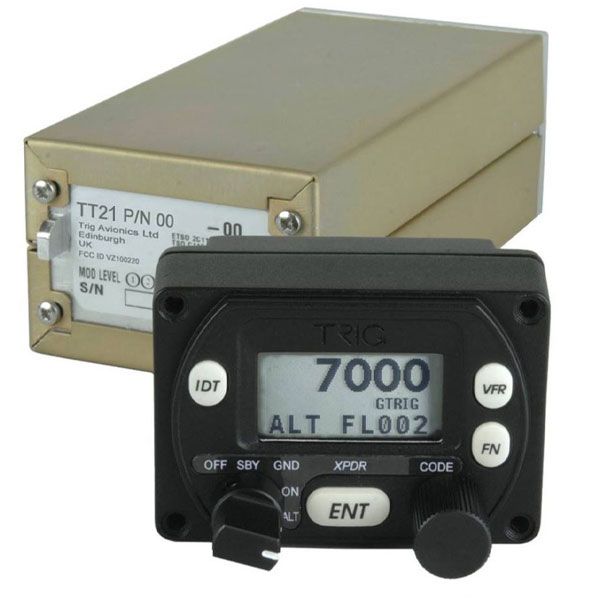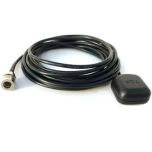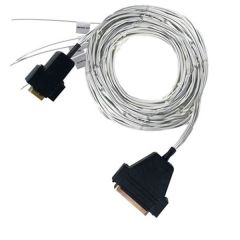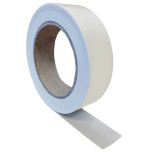Trig TT21 Mode S Class 2 Compact Transponder
Manufacturer Part Number: 00710-00
Trig TT21 Cass 2 Compact Transponder
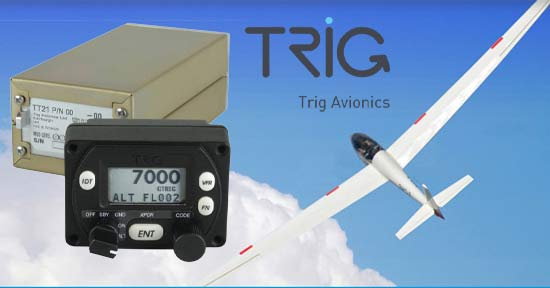

General Description
Trig TT21 Class 2 Compact Transponder is chosen by pilots around the world. Trig's compact transponders are the best choice for good reason.
Fitting in the tightest panel space our innovative design saves weight and space. Trig is ‘better by design’ our Mode S technology makes you visible to commercial, military and GA traffic, as a result transiting busy airspace becomes more predictable and stress-free. Our transponders are future proof too – the growing use of ADS–B further enhances your visibility and flight safety. Unlike other brands Trig transponders meet the very latest certification standard for ADS–B, FAA TSO–C166b.
Designed to be easier to use, with a clear bright display the controller even comes with a built-in altitude encoder! Join other pilots who have made Trig their compact transponder of choice – you’ll be in great company.
Growing numbers of air sports pilots are transponder equipped with Mode S. In the past this has been difficult, space and weight being limiting factors. Trig makes the world’s smallest Mode S transponders, so now you can have more certainty flying in controlled air space – being seen and being safe. Using Mode S can reduce the frequency of position reporting, giving you more time to focus on your flying, adding to your flying pleasure.
Glider customers in the U.S. looking to get ADS-B equipped should look at our ADS-B Glider Cert. Type document. This highlights equipment and regulations for both certified and experimental gliders.
Customers in the U.S. should be aware that FAA, Federal Aviation Regulations (FAR) 91.227 requires that a compliant ADS-B Out solution uses a Class 1 transponder. The TT22 is a Class 1 device and meets this requirement. The TT21 is a Class 2 device and does not meet this regulation.


| Specification | TT21 Transponder | TT22 Transponder |
| Type | Transponder Class 2 Mode S level 2els ADS–B Class B0 |
Transponder Class 1 Mode S level 2els ADS–B Class B1S |
| Certification | ETSO C88A, C112C, C166A TSO C88b, C112c, C166b, approved for IFR and VFR flight |
| Compliance | ED–73C, DO–160F, DO–178B Level B, DO–254 Level C, DO–260B, DO–181D |
| Supply voltage (DC) | 9–33 V |
| Typical consumption (at 14v) | idle: 0.15 A active: 0.28 A | idle: 0.15A active: 0.34 A |
| Nominal Transmitter Power | 130 W at connector | 250 W at connector |
| Operating Temperature | for the transponder –40°C to +70°C for the controller –25°C to +70°C |
| Cooling Requirement | No Fan Required |
| Weight | 440g / 0.8 lbs |
| Dimensions (mm) | controller: H 44 x W 63 x L 54 mm transponder in tray: H 48 x W 68 x L 160 mm |
| Dimensions (inches) | controller: H 1.8 x W 2.4 x L 2.1″ transponder in tray: H 1.8 x W 2.6 x L 6.2″ |
| Circuit Breaker | 3 Amp (SKU 2723) |
 |
 |
ADS-B OUT
(1090ES ADS-B Out is the international standard and can be used worldwide)


ADS-B OUT AND ADS-B IN
This illustrates aircraft operating within a full ADS-B environment. Note that ground services are only available in the U.S. (these include weather and traffic services).
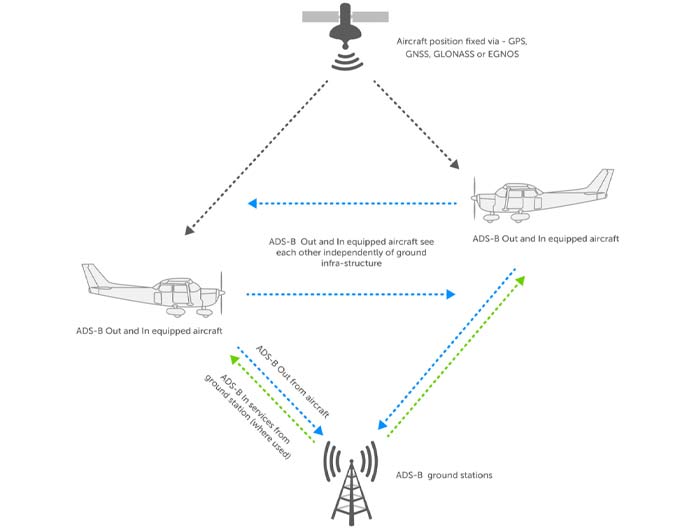

ADS-B uses a Trig transponder, typically combined with a GPS, to transmit highly accurate positional is information to ground controllers and also directly to other aircraft. This transmission is known as ADS-B Out and its accuracy is greater than using conventional radar surveillance. This gives air traffic controllers the potential to reduce the required separation distance between aircraft that are ADS-B equipped.
ADS-B is seen as being vital to maintaining future efficient airspace management in busy airspace. It also provides advantages in remote ‘non radar’ areas too – here suitably equipped aircraft, with a traffic receiver connected to a display can see other aircraft without conventional radar coverage. This enhances aircraft visibility and reduces the risk of air to air collision.
ADS-B uses satellite and transponder technology to provide the following benefits in an ADS-B environment:
More aircraft can operate safely in the same airspace, so congestion is reduced.
ADS-B technology enables more direct aircraft routing – this can generate significant time and fuel savings.
With appropriate equipment it’s possible to have a live ‘traffic picture’ in the cockpit.
ADS-B enhances flight safety and collision avoidance.
Aircraft with ADS-B Out provide air traffic controllers with ‘pin point’ positional and flight information data. Trig supports 1090ES, the ICAO international standard for ADS-B that can be used throughout the world.
- TT21 Transponder
- TC20 Conrol Head
- Mounting Tray
- Installation manual and Operating manual (in English, German and French)
Installation kit:
Mounting adapter (circular hole adapter)
Connector Co-axial TNC (1)
Headshell, 9 Way (1)
Headshell, 25 way (1)
9 way D-type contact housing (female) (1)
25 way D-type contact housing (male) (1)
Crimp Terminal, Male, 22-24 AWG (20)
Crimp Terminal, Female, 22-24 AWG (9)
Static tubing, EPDM 5mm ID (1)
Hose T piece (1)
Hose Adapter (2)
Hose clip, small (6)
Hose clip, large (2)
Long mounting screws, 4-40 thread (4)
Short mounting screws, 4-40 thread (4) - EASA Form One
- All Trig products come with a two year warranty, starting from the day of installation


Experimental Glider


Certified Glider


What is the difference between the TT21 and the TT22?
Both models have the same physical dimensions and advantages of size and ease of installation. The TT21 is a 130 watt Class 2 transponder; this makes it ideal for light sports and regular GA use. The TT22 is a 250 watt Class 1 transponder, ideally suited to higher performance and/or high altitude performance types.
In the U.S. the FAA has stated that Class 1 transponders must be used to be ‘2020 complaint’ For U.S. customers Trig recommends the TT22 unit for this reason.
Is the controller display visible in all lighting conditions?
Yes! The LCD display is clear and crisp in all lighting, full sunlight generates a very clear contrast and in dull or dark lighting the inbuilt lighting ensures the unit remains clear and legible. The controller has a backlight and manual dimming can be selected to increase or decrease brightness.
Is the controller easy to use?
Yes! One handed operation is simple. The Squawk code is easily entered using fingers to rotate the ‘CODE’ dial whilst the thumb is used to press the ‘ENT’ key. All operations can be performed whilst wearing flying gloves.
How does the compact fit or the round mount installation work?
The transponder control head, the TC20 can be installed either as a space saving compact mount or in a 57 mm round hole. Click on the 'specification tab' of this web page to see an image of the installation kit, in the technical images area. This photo features all the components contained in the install kit. This includes the two plastic blanking plates and long screws that are used to fit the TC20 control head into a 57 mm round hole. Once installed, the full round mount is a tough and durable solution, it looks great in both modern and vintage aircraft. The kit also includes a template to assist you in cutting an accurate compact mount in the panel, if that is required.
Can I use the Transponder in open cockpit flying?
The TC20 controller is splash proof. This makes it suitable for use in open cockpit aircraft, where the weather can sometimes be in the cockpit and not just outside it!
In Europe, how do I get a free minor change?
Free minor changes for the TT21 and TT22 are available, see our minor change library. You may also consider the alternative EASA approval called CS-STAN this is especially suited to VFR aircraft.
Does the TT21 have an STC?
No.
Does the TT22 have an STC?
Yes, Trig has a free STC with an AML list of over 576 types.
In the U.S. installing a compliant ADS-B Out solution (in a certified aircraft) requires your Trig transponder to utilise a certified WAAS GPS, this provides a compliant ADS-B position source. The FAA also requires that a certified ADS-B installation is completed in accordance with an FAA STC approval (Supplementary Type Certificate).
Our ADS-B STC’s are available free of charge and cover hundreds of aircraft types. Trig STC approvals allow the use of popular WAAS GPS navigators too – making installation more practical and cost-effective. Our TA70 GPS antenna has also been added to our STC equipment list.
Versions
| Model | Type | Meets TSO-C166b | Suitable for 2020 ADS-B rule airspace (US) | Transmitter Output |
| TT21 | Class 2 Mode – S and 1090ES ADS-B Out capable |
Yes | No – FAR 91.227 requires a Class 1 device – select the TT22. | 130 W at connector |
| TT22 | Class 1 Mode – S and 1090ES ADS-B Out capable |
Yes | Yes | 250 W at connector |
W&W typically stocks Trig TT21 Class 2 Compact Transponder.

